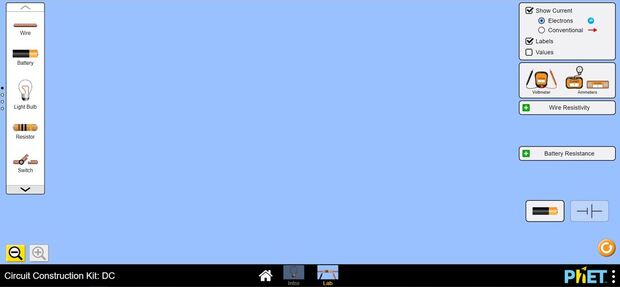It's STEM Challenge time! This week we are taking on the study of circuits and electricity! Students in older grades are asked to design a complete simple circuit and explain the necessary components (S5P2.b). For this week's challenge, students will also be asked to exercise their math skills by identifying acute, right, and obtuse angles that exist in their circuits (MGSE4.G.1).
Materials: paper pencil computer
This week, we are going to start with an amazing song that explains the basics of current (or moving) electricity. Watch it once to enjoy the animation and beat, watch it again to be sure you understand what the words are teaching you! Type in your name and click "Join Session" below. This session will stay active until May 23rd.
Materials: paper pencil computer
This week, we are going to start with an amazing song that explains the basics of current (or moving) electricity. Watch it once to enjoy the animation and beat, watch it again to be sure you understand what the words are teaching you! Type in your name and click "Join Session" below. This session will stay active until May 23rd.
Let's jump into it! This week's challenge is going to look a little different. You are going to open a digital circuit builder and then scroll down for your specific challenges- you will have to click back and forth between this screen and your circuit builder screen. This circuit builder has a built-in tutorial if you're not sure how to use it! Click on the image below to open it up, then come back for your challenges below!
Now that you've found the circuit builder, here are your challenges for this week!
CHALLENGE 1: Light the light bulb
You may use: ONE light bulb, ONE battery, and ONE wire. I promise it's possible!
Math connection: Can you identify ONE acute angle in your circuit?
CHALLENGE 2: Light the light bulb
You may use: ONE light bulb, ONE battery, and TWO wires
Math connection: Give your circuit ONE right angle.
CHALLENGE 3: Light the bulb with a switch
You may use: ONE light bulb, ONE battery, THREE wires, and ONE switch.
Math connection: How many angles can you find and record?
STEM ENGINEERING CHALLENGE:
Ask yourself, can I construct a testing station to see if common items will allow electricity to pass through them? We call materials that allow electricity to flow CONDUCTORS. We call materials that stop electricity INSULATORS. Use the down arrows on your tool bar to get to some materials for testing. You should see things like a dollar bill, eraser, a coin, and more! Brainstorm a way to see if these items will allow electricity to pass through them. Create a circuit with a gap for testing! Try out some different things to see if they are conductors or insulators. Record your results! Evaluate your design- could you tell which items were conductors and which were insulators? Improve your design if you need to!
Did you get stuck? Scroll down for some pictures of possible correct solutions for the challenges!
Keep scrolling for answers!
Here are a few possible answers! Yours might look a little different depending on where you put the parts, but as long as you used the correct number of pieces and lit the bulb, you did it!
CHALLENGE 1: Light the light bulb
You may use: ONE light bulb, ONE battery, and ONE wire. I promise it's possible!
Math connection: Can you identify ONE acute angle in your circuit?
CHALLENGE 2: Light the light bulb
You may use: ONE light bulb, ONE battery, and TWO wires
Math connection: Give your circuit ONE right angle.
CHALLENGE 3: Light the bulb with a switch
You may use: ONE light bulb, ONE battery, THREE wires, and ONE switch.
Math connection: How many angles can you find and record?
STEM ENGINEERING CHALLENGE:
Ask yourself, can I construct a testing station to see if common items will allow electricity to pass through them? We call materials that allow electricity to flow CONDUCTORS. We call materials that stop electricity INSULATORS. Use the down arrows on your tool bar to get to some materials for testing. You should see things like a dollar bill, eraser, a coin, and more! Brainstorm a way to see if these items will allow electricity to pass through them. Create a circuit with a gap for testing! Try out some different things to see if they are conductors or insulators. Record your results! Evaluate your design- could you tell which items were conductors and which were insulators? Improve your design if you need to!
Did you get stuck? Scroll down for some pictures of possible correct solutions for the challenges!
Keep scrolling for answers!
Here are a few possible answers! Yours might look a little different depending on where you put the parts, but as long as you used the correct number of pieces and lit the bulb, you did it!

 RSS Feed
RSS Feed